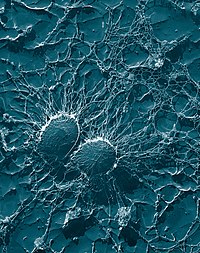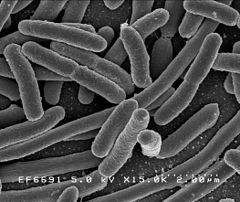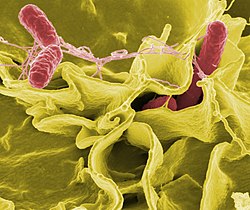List of human microbiota
Human microbiota are microorganisms (bacteria, viruses, and archaea) found in a specific environment. They can be found in stomachs, intestines, skin, genitals and other parts of the body.[1] Various body parts have diverse microorganisms. Some microbes are specific to certain body parts and others are associated with many microbiomes. This article lists some of the species recognized as belonging to the human microbiome and focuses on the oral, vaginal, ovarian follicle, uterus and the male reproductive tract microbiota.
Categories of bacteria[edit]
The "reference" 70 kg human body is estimated to have around 39 trillion bacteria with a mass of about 0.2 kg.[2][3][4][5] These can be separated into about 10,000 microbial species. about 180 of the most studied is listed below here. However, these can broadly be put into three categories:[6]
Spheres or ball-shaped (cocci bacteria).[edit]
- They are ususally round or spherical in shape. They can form clusters and are non motile.[7] Examples include Staphylococcus aureus, Streptococcus pyogenes, and Neisseria gonorrhea.

Staphylococcus aureus
Rod-shaped bacteria (bacilli).[edit]
As the name implies, these usually have a rod or cylinder shape.Bacillus are generally rod shaped bacteria. Examples include listeria, Salmonella typhimurium, Yersinia enterocolitica, Escherichia coli



Spirals or helixes (spirochetes)[edit]
These are usually spiral or corkscrew shaped and moved by axial filament. Examples include Treponema pallidum and Leptospira borgpetersenii[8]

Naming convention for the table[edit]
| Column | Description |
|---|---|
| Binomial name | Name of the species, Ideally including the shape of the bacteria |
| Location | Where it can be found in the body |
| Pathological? | Can it harm humans or is it useful? the scale goes Not, Mostly not, Sometimes, Useful |
| % of total Microbiome? | How many % does the bacteria in number of organisms make out of the entire human microbiome |
Vagina[edit]
The vaginal microbiota is shaped by puberty, pregnancy and menopause. Vaginal microbiota including some Lactobacilli species protect the vagina from harmful pathogens.[9] They convert glucose to lactic acid and this acidic environment kills harmful pathogens. The vaginal microbiota in pregnancy varies markedly during the entire time of gestation. The species and diversity of the microorganisms may be related to the various levels of hormones during pregnancy. Vaginal flora can be transmitted to babies during birth. Vaginal dysbiosis can lead to vaginal infections like bacterial vaginosis which makes one relatively susceptible to sexually transmitted diseases. Good personal hygiene and probiotics promote a healthy vaginal microbiota.[10]
Uterus[edit]
The healthy uterine microbiome has been identified and over 278 genera have been sequenced. Bacteria; species like Fusobacterium are typically found in the uterus.[11] Although Lactobacillus may be beneficial in the vagina, “increased levels in the uterus through a breach in the cervical barrier” may be harmful to the uterus.[12]
Ovarian follicle[edit]
The ovarian follicle microbiome has been studied using standard culturing techniques. It has been associated with the outcomes of assisted reproductive technologies and birth outcomes. Positive outcomes are related to the presence of Lactobacilli spp while the presence of Propionibacterium and Actinomyces were related to negative outcomes. The microbiome can vary from one ovary to the other. Studies are ongoing in the further identification of those bacteria present.[12]
Male reproductive tract[edit]
The microbiome present in seminal fluid has been evaluated. Using traditional culturing techniques the microbiome differs between men who have acute prostatitis and those who have chronic prostatitis. Identification of the seminal fluid microbiome has become one of the diagnostic tools used in treating infertility in men that do not display symptoms of infection or disease. The taxa Pseudomonas, Lactobacillus, and Prevotella display a negative effect on the quality of sperm. The presence of Lactobacillus spp in semen samples is associated with a very high normal sperm count.[12]
Mouth[edit]
The oral microbiota consists of all the microorganisms that exist in the mouth. It is the second largest of the human body and made of various bacteria, viruses, fungi and protozoa.[13] These organisms play an important role in oral and overall health. Anthony Van Leeuwenhoek was the first to view these organisms using a microscope he created2. The temperature and pH of saliva makes it conducive for bacteria to survive in the oral cavity. Bacteria in the oral cavity include Streptococcus mutans, Porphyromonas gingivalis, and Staphylococcus.[14] S. mutans is the main component of the oral microbiota.
A healthy oral microbiome decreases oral infections and promotes a healthy gut microbiome. However, when disturbed can lead to gum inflammations and bad breath.[15] Dental plaque is formed when oral microorganisms form biofilms on the surfaces of teeth.[16] Recommended practices to maintain a healthy oral microbiome include practicing good oral hygiene (brushing twice and flossing, replacing toothbrush often), eating healthy diet (food with little or no added sugars and ultra processed foods), drinking lots of water and taking probiotics.[16]
See also[edit]
- Placental microbiome
- List of bacterial vaginosis microbiota
- List of microbiota species of the lower reproductive tract of women
- Lung microbiota
- Gut microbiota
- Skin flora
- https://www.wikidata.org/wiki/Q1591401
Other lists of the human body's contents and building bricks[edit]
- List of skeletal muscles of the human body
- List of organs of the human body
- List of distinct cell types in the adult human body
References[edit]
- ^ Hou K, Wu ZX, Chen XY, Wang JQ, Zhang D, Xiao C, et al. (April 2022). "Microbiota in health and diseases". Signal Transduction and Targeted Therapy. 7 (1): 135. doi:10.1038/s41392-022-00974-4. PMC 9034083. PMID 35461318.
- ^ Sender R, Fuchs S, Milo R (August 2016). "Revised Estimates for the Number of Human and Bacteria Cells in the Body". PLOS Biology. 14 (8): e1002533. doi:10.1371/journal.pbio.1002533. PMC 4991899. PMID 27541692.
- ^ Abbott A (2016-01-08). "Scientists bust myth that our bodies have more bacteria than human cells". Nature. doi:10.1038/nature.2016.19136. ISSN 1476-4687.
- ^ "Do our bodies contain far more bacteria than human cells?". handling-solutions.eppendorf.com. 2022-01-10. Retrieved 2023-07-16.
- ^ "NIH Human Microbiome Project defines normal bacterial makeup of the body". National Institutes of Health (NIH). 2015-08-31. Retrieved 2023-07-16.
- ^ "Bacteria: Definition, Types, Benefits, Risks & Examples". Cleveland Clinic. Retrieved 2023-07-16.
- ^ "Cocci or Cocus Bacteria: Structure, Types and Examples". Toppr-guides. 2019-10-31. Retrieved 2024-05-04.
- ^ Krieg NR, Padgett PJ (2011), Phenotypic and Physiological Characterization Methods, Methods in Microbiology, vol. 38, Elsevier, pp. 15–60, doi:10.1016/b978-0-12-387730-7.00003-6, ISBN 978-0-12-387730-7
- ^ Kovachev S (February 2018). "Defence factors of vaginal lactobacilli". Critical Reviews in Microbiology. 44 (1): 31–39. doi:10.1080/1040841X.2017.1306688. PMID 28418713.
- ^ Fox C, Eichelberger K (December 2015). "Maternal microbiome and pregnancy outcomes". Fertility and Sterility. 104 (6): 1358–1363. doi:10.1016/j.fertnstert.2015.09.037. PMID 26493119.
- ^ Baker JM, Chase DM, Herbst-Kralovetz MM (2018-03-02). "Uterine Microbiota: Residents, Tourists, or Invaders?". Frontiers in Immunology. 9: 208. doi:10.3389/fimmu.2018.00208. PMC 5840171. PMID 29552006.
- ^ a b c Franasiak JM, Scott RT (December 2015). "Reproductive tract microbiome in assisted reproductive technologies". Fertility and Sterility. 104 (6): 1364–1371. doi:10.1016/j.fertnstert.2015.10.012. PMID 26597628.
- ^ Deo PN, Deshmukh R (2019). "Oral microbiome: Unveiling the fundamentals". Journal of Oral and Maxillofacial Pathology. 23 (1): 122–128. doi:10.4103/jomfp.JOMFP_304_18. PMC 6503789. PMID 31110428.
- ^ Lu M, Xuan S, Wang Z (March 2019). "Oral microbiota: A new view of body health". Food Science and Human Wellness. 8 (1): 8–15. doi:10.1016/j.fshw.2018.12.001.
- ^ Strużycka I (2014). "The Oral Microbiome in Dental Caries". Polish Journal of Microbiology. 63 (2): 127–135. doi:10.33073/pjm-2014-018. ISSN 2544-4646.
- ^ a b Lee S (2021-05-29). "10 health benefits of having a probiotic oral microbiome". Leeming Dental. Retrieved 2024-05-04.

